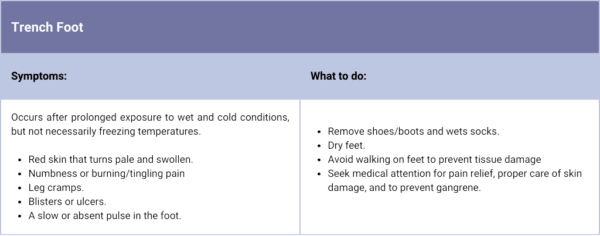Stay safe while working in cold weather
Parts of B.C. are experiencing extreme winter weather. Here are some health and safety tips if you are working outdoors or driving to and from work.
Working outdoors
Working in cold, windy, and wet weather, even for minutes at a time, can lead to cold exposure injuries. Learn the signs and symptoms and what you can do if you, your coworkers, patients, clients, or residents experience cold exposure injuries. Notify your employer and seek medical attention when required.
Protect yourself
- Wear appropriate clothing and monitor your physical condition:
-
- Wear several layers of loose clothing for insulation.
- Wear loose clothing because tight clothing reduces blood circulation to the
- Wear a hat to reduce the loss of body heat from your head.
- Protect the ears, face, hands, and feet in extremely cold or wet weather by wearing hat, scarf, and gloves.
- Choose waterproof and insulated footwear.
- Be aware that some clothing may restrict movement resulting in a hazardous situation.
- Move into warm locations during breaks; limit the amount of time outside.
- Include chemical hot packs in your first aid kit.
- Avoid touching cold metal surfaces with bare skin.
- Carry an emergency kit that includes extra socks, gloves, hats, jacket, blankets, a change of clothes, an energy bar/snack, and a thermos of hot liquid.
Cold Exposure Injuries:

 There are varying severities to frostbite, to learn more visit HealthLinkBC.
There are varying severities to frostbite, to learn more visit HealthLinkBC.


Adapted from HealthLinkBC (2022) and NIOSH (2024). Cold Temperature Exposure and Hypothermia and Cold Temperature Exposure and NIOSH Fast Facts: Protecting Yourself from Cold Stress
Driving to and from work
Winter driving in BC can be dangerous. Cold temperatures, slippery roads, and reduced visibility are challenging even for the most experienced drivers. The risks are high no matter where you live. Learn how to keep yourself, your coworkers, patients, clients, and residents safe.
Prepare before you go with these tips from Road Safety at Work:
- Check current weather and road conditions by visiting DriveBC
- Give yourself extra time and let someone know where you are going and when you expect to be arriving.
- Bring warm clothing such as winter boots with good tread, a coat, gloves, a blanket, and a hat with you in case you need to get out of your vehicle during the trip or if you are stranded in your vehicle.
- Check your tire tread. Winter tires are a legal requirement on most BC highways and mountain passes October 1 through April 30. The ideal winter tire tread depth is 7/32 (or 50% worn) and the tire should have the M+S (mud and snow) or mountain icon. as shown here:

- Practice preventative maintenance year-round to ensure your vehicle is prepared for winter.
- Clear all windows, lights, mirrors, hood, and the roof of snow and ice before driving using a snowbrush or broom.
- Drive below the posted speed.
- Increase your following distance.
- Accelerate/brake slowly and avoid sudden moves.
- Watch for black ice (slow down when approaching icy areas).
- Know how to handle a skid – If you start to skid, ease off the brake or accelerator and look and steer in the direction you want to go. Smooth steering is the key to recovering.
- Maintain a safe following distance around all highway maintenance vehicles such as plows and salt or sand trucks.
To learn more about employee responsibilities and employer responsibilities for your health and safety when driving visit here.





